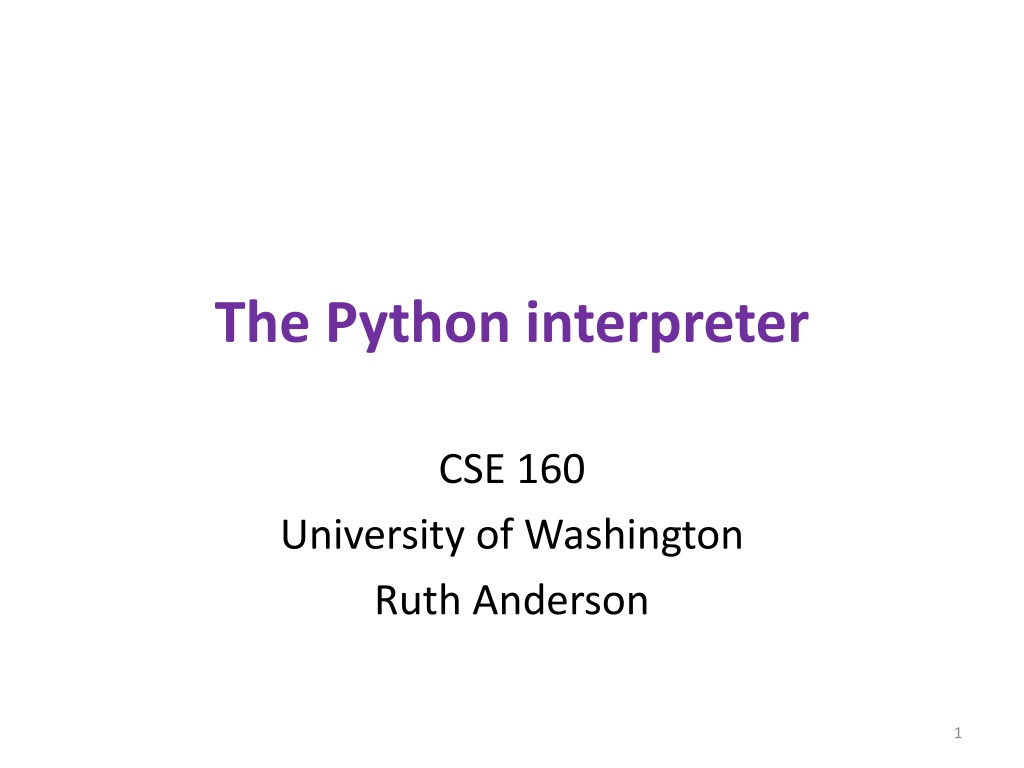Understanding Python Interpreter and Running Python Programs
The content explains the concept of the Python interpreter, its role in evaluating expressions, running Python programs, launching the interpreter in Canopy, and the differences between running code in the interpreter vs. running a Python file as a program. It covers the basics of interacting with the Python interpreter, running Python programs in Canopy, and executing programs from the command line. The article also clarifies the distinctions between the interpreter and running Python programs, highlighting the different outputs and behaviors.
Download Presentation

Please find below an Image/Link to download the presentation.
The content on the website is provided AS IS for your information and personal use only. It may not be sold, licensed, or shared on other websites without obtaining consent from the author. Download presentation by click this link. If you encounter any issues during the download, it is possible that the publisher has removed the file from their server.
E N D
Presentation Transcript
The Python interpreter CSE 160 University of Washington Ruth Anderson 1
Two ways to run Python The Python interpreter You type one expression at a time The interpreter evaluates the expression and prints its value Running a Python program Python evaluates all the statements in the file, in order Python does not print their values (but does execute print statements) Writing an expression outside a statement (assignment, print, etc.) is useless, unless it is a function call that has a side effect 2
The Python interpreter The interpreter is a loop that does: Read an expression Evaluate the expression Print the result If the result is None, the interpreter does not print it This inconsistency can be confusing! (Jargon: An interpreter is also called a read- eval-print loop , or a REPL) 3
How to launch the Python interpreter Two ways to launch the interpreter: Run Canopy; in the window labeled Python you should see: Welcome to Canopy's interactive data-analysis environment! This window is a Python interpreter called the ipython shell* Type python or ipython at the operating system command line Type exit() to return to the operating system command line These are not the same: Operating system command line, or shell or command prompt (cmd.exe under Windows) or terminal Runs programs (Python, others), moves around the file system Does not understand Python code like 1+2 or x = 22 Python interpreter Executes Python statements and expressions Does not understand program names like python or cd * The ipython shell is what is shown in Canopy. You can access either the python shell or the ipython shell from the operating system command line. The ipython shell has more features than the python shell, but both are Python interpreters. 4
Running a Python program Python evaluates each statement one-by-one Python does no extra output, beyond print statements in the program Two ways to run a program: While editing a program within Canopy: press the green triangle/play button Hit Control and the letter R at the same time Select the menu item Run >> Run File Type at operating system command line: python myprogram.py 5
Python interpreter vs. Python program Running a Python file as a program gives different results from pasting it line-by-line into the interpreter The interpreter prints more output than the program would In the Python interpreter, evaluating a top-level expression prints its value Evaluating a sub-expression generally does not print any output The interpreter does not print a value for an expression that evaluates to None This is primarily code that is executed for side effect: assignments, print statements, calls to non-fruitful functions In a Python program, evaluating an expression generally does not print any output 6
Side effects vs. results Some Python code is executed because it has a useful value (72 32) * 5.0 / 9 math.sqrt(3*3 + 4*4) Some Python code is executed because it has a side effect print hello x = 22 A function (call) can be of either variety Think Pythoncalls a function that returns a value a fruitful function A function that only prints some text is non-fruitful A function should either return a value, or have a side effect It is bad style for a function to do both Printing a value is completely different from returning it When the code is executed for a side effect, its value is None 7























